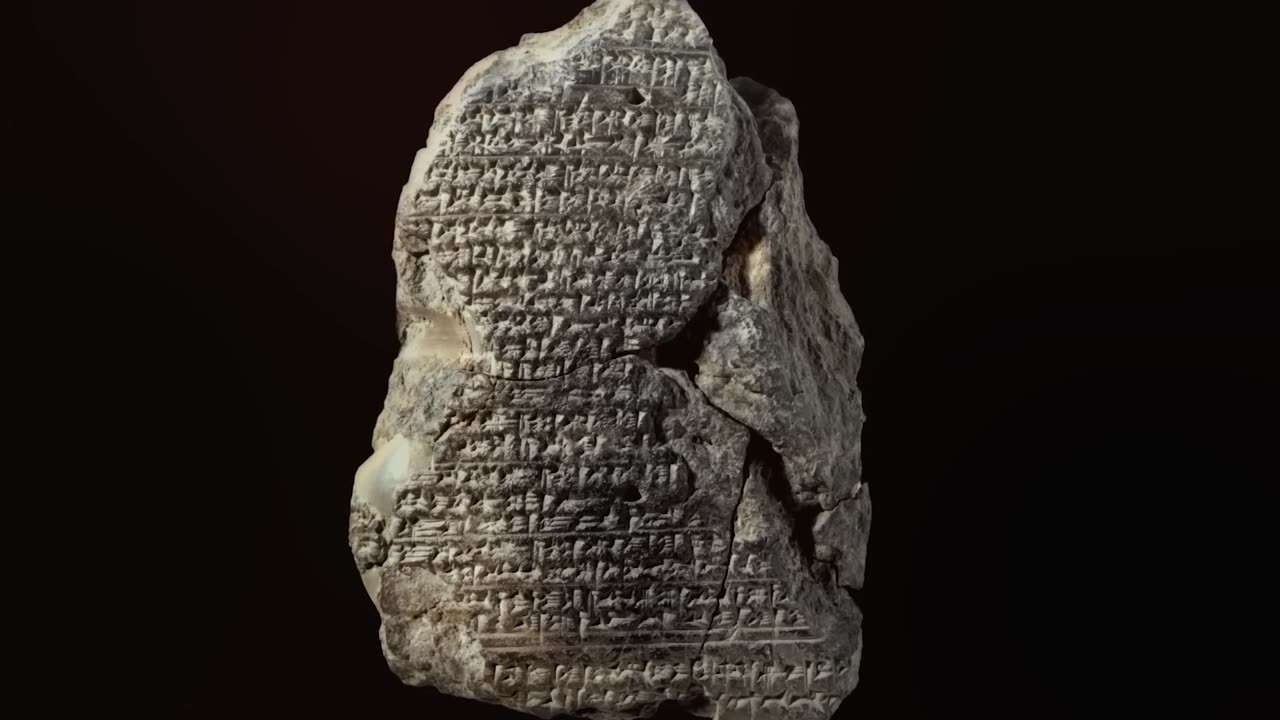Premium Only Content

The Babylonian Map of the World
The Babylonian Map of the World (also Imago Mundi or Mappa mundi) is a Babylonian clay tablet with a schematic world map and two inscriptions written in the Akkadian language. Dated to no earlier than the 9th century BC (with a late 8th or 7th century BC date being more likely), it includes a brief and partially lost textual description. The tablet describes the oldest known depiction of the known world. Ever since its discovery there has been controversy on its general interpretation and specific features.[1] Another pictorial fragment, VAT 12772, presents a similar topography from roughly two millennia earlier.[2]
The map is centered on the Euphrates, flowing from the north (top) to the south (bottom), with its mouth labelled "swamp" and "outflow". The city of Babylon is shown on the Euphrates, in the northern half of the map. Susa, the capital of Elam, is shown to the south, Urartu to the northeast, and Habban, the capital of the Kassites, is shown (incorrectly) to the northwest. Mesopotamia is surrounded by a circular "bitter river" or Ocean, and seven or eight foreign regions are depicted as triangular sections beyond the Ocean, perhaps imagined as mountains.[3]
The tablet was excavated by Hormuzd Rassam at Sippar, Baghdad vilayet,[4] some 60 km north of Babylon on the east bank of the Euphrates River. It was acquired by the British Museum in 1882 (BM 92687);[4] the text was first translated in 1889.[5] The tablet is usually thought to have originated in Borsippa.[6] In 1995, a new section of the tablet was discovered, at the point of the upper-most triangle.[7]
The map is used as the logo of the academic journal Imago Mundi.[8]
Description of the tablet
The tablet consists of three parts: the world map, a text above it, and a text on the reverse side. It is not clear whether all three parts should be read as a single document. Systematic differences between the texts suggest that the tablet may have been compiled from three separate documents.[9]
The map
Babylonian Map of the World with false color
The map is circular with two boundary circles. Cuneiform script labels all locations inside the circular map, as well as a few regions outside. The two circles represent a body of water labelled idmaratum "bitter river", the salt sea. Babylon is marked north of center; parallel lines at the bottom seem to represent the southern marshes, and a curved line coming from the north-northeast appear to represent the Zagros Mountains.[10] [11] [12][13][14]
Drawing by B. Meissner in Babylonien und Assyrien, 1925.
There are seven small interior circles within the perimeter of the circle, appearing to represent seven cities. Seven or eight triangular sections outside the water circle represent named "regions" (nagu). The descriptions for five of them have survived.[4]
Objects on the Babylonian map of the world[10]
1. "Mountain" (Akkadian: šá-du-ú)
2. "City" (Akkadian: uru)
3. Urartu (Akkadian: ú-ra-áš-tu)
4. Assyria (Akkadian: kuraš+šurki)
5. Der (Akkadian: dēr) (a city)
6. ?
7. Swamp (Akkadian: ap-pa-ru)
8. Susa (capital of Elam) (Akkadian: šuša)
9. Canal/"outflow" (Akkadian: bit-qu)
10. Bit Yakin (Akkadian: bῑt-ia-᾿-ki-nu) (a region)
11. "City" (Akkadian: uru)
12. Habban (Akkadian: ha-ab-ban) (a Kassite land and city)
13. Babylon (Akkadian: tin.tirki), divided by Euphrates
14 – 17. Ocean (salt water, Akkadian: idmar-ra-tum)
19 – 22 (and 18?). outer "regions" (nagu):
18. "Great Wall, 6 leagues in between, where the Sun is not seen" (Akkadian: BÀD.GU.LA 6 bēru ina bi-rit a-šar Šamaš la innammaru). – The "Great Wall" may be a mountain ridge, the "6 leagues in between" probably refer to the width of the Ocean.[15]
19. "nagu, 6 leagues in between"
20. "[nag]u [..." (rest of text missing)
21. "[na]gu [..." (rest of text missing)
22. "nagu, 8 leagues in between"
23. No description. (a city in Assyria?)
24, 25. No description. (cities in Habban?)
Accompanying texts
Front side
The text above the map[16] (11 lines) seems to describe part of the creation of the world by Marduk, the patron god of Babylon, who parted the primeval Ocean (the goddess Tiamat) and thus created Land and Sea. Of the Sea it says:
the ruine[d] gods which he (Marduk) set[tled] inside the Sea [...] are present; the viper, the great sea-serpent inside.
Next, on Land, a series of two mythical creatures ("the Anzu-bird, and scorpi[on-man]") and at least fifteen land animals are mentioned, "beasts which Marduk created on top of the res[tl]ess Sea" (i.e. on the land, visualized as a kind of giant raft floating in the Sea), among them mountain goat, gazelle, lion, wolf, monkey and female-monkey, ostrich, cat, and chameleon. With the exception of the cat, all these animals were typical of faraway lands.
The last two lines of the text refer to three legendary heroes: [U]tnapištim (the hero of the Flood), Sargon (ruler of Akkad), and Nur-[D]agan the King of Buršaḫa[nda] (opponent of Sargon).[17]
Back side
The back side[18] (29 lines) seems to be a description of (at least) eight nagu. After an introduction, possibly explaining how to identify the first nagu, the next seven nagu are each introduced by the clause "To the n-th region [nagu], where you travel 7 leagues" (the distance of 7 leagues seems to indicate the width of the Ocean, rather than the distance between subsequent nagu).[19]
A short description is given for each of the eight nagu, but those of the first, second, and sixth are too damaged to read. The fifth nagu has the longest description, but this too is damaged and uncomprehensible. The seventh nagu is more clear:
... where cattle equipped with horns [are ...] they run fast and reach [...]
The third nagu may be a barren desert, impassable even for birds:
A winged [bi]rd cannot safely comp[lete its journey]
In the fourth nagu objects are found of remarkable dimensions:
[...] are thick as a parsiktum-measure, 20 fingers [...]
The eighth nagu may refer to a supposed heavenly gate in the east where the Sun enters as it rises in the morning.
[... the p]lace where [...] dawns at its entrance.
Concluding, the description then states that the map is a bird's eye description:
of the Four Quadrants of the entire [world?] [...] which no one can compre[hend] [i.e., the nagu extend infinitely far]
The last two lines apparently recorded the name of the scribe who wrote the tablet:
[...] copied from its old exemplar and colla[ted ...] the son of Iṣṣuru [the descend]ant of Ea-bēl-il[ī].
Later influence
Carlo Zaccagnini has argued that the design of the Babylonian map of the world may have lived on in the T and O maps of the European Middle Ages.
-
 LIVE
LIVE
Wendy Bell Radio
4 hours agoTrump Wins Again
8,437 watching -
 1:26:51
1:26:51
JULIE GREEN MINISTRIES
2 hours agoLIVE WITH JULIE
54.8K115 -
 1:25:49
1:25:49
Game On!
17 hours ago $4.29 earnedThe Masters 2025 is HERE!
10K -
 LIVE
LIVE
Canada Strong and Free Network
1 hour agoCanada Strong and Free Network
127 watching -
 8:33
8:33
SKAP ATTACK
17 hours ago $2.28 earnedWhat Went Wrong With the Nuggets
28K4 -
 23:51
23:51
JasminLaine
16 hours agoCBC STUNNED Into Silence as Carney PANICS—Defends Bill C-69 and His Foreign Profits
12.6K22 -
 17:25
17:25
World2Briggs
13 hours ago $1.71 earnedThe Dark Reality Of Human Trafficking In The United States
10.6K11 -
 4:31
4:31
Mrgunsngear
15 hours ago $5.69 earnedBreaking: Kash Patel No Longer ATF Director! Replacement Has Been Named
25.5K12 -
 43:42
43:42
Esports Awards
23 hours agoAustinJohnPlays on Pokémon Card Collection & Evolution of YouTube | Origins Podcast #2
10.1K -
 59:35
59:35
Trumpet Daily
21 hours ago $4.38 earnedStrongman Stare Down - Trumpet Daily | Apr. 9, 2025
23.6K6